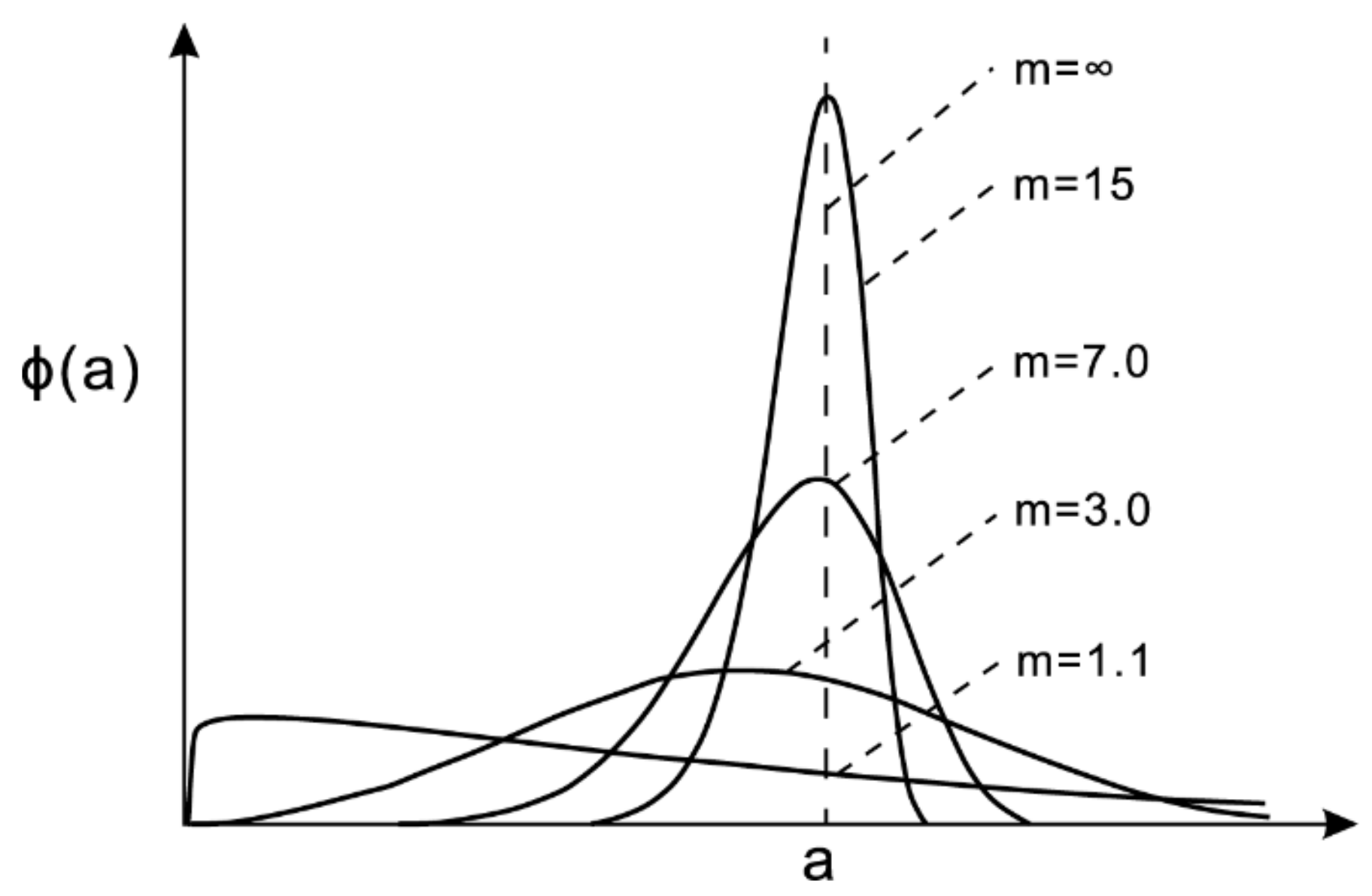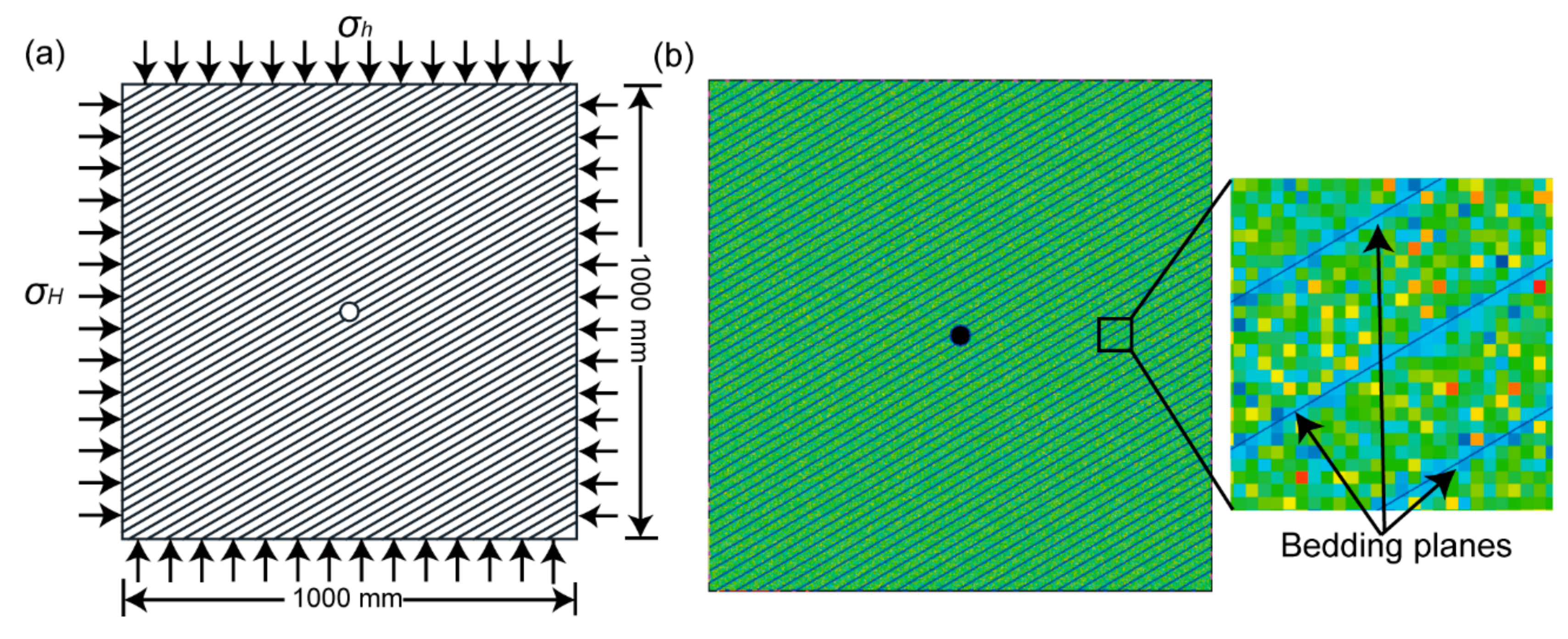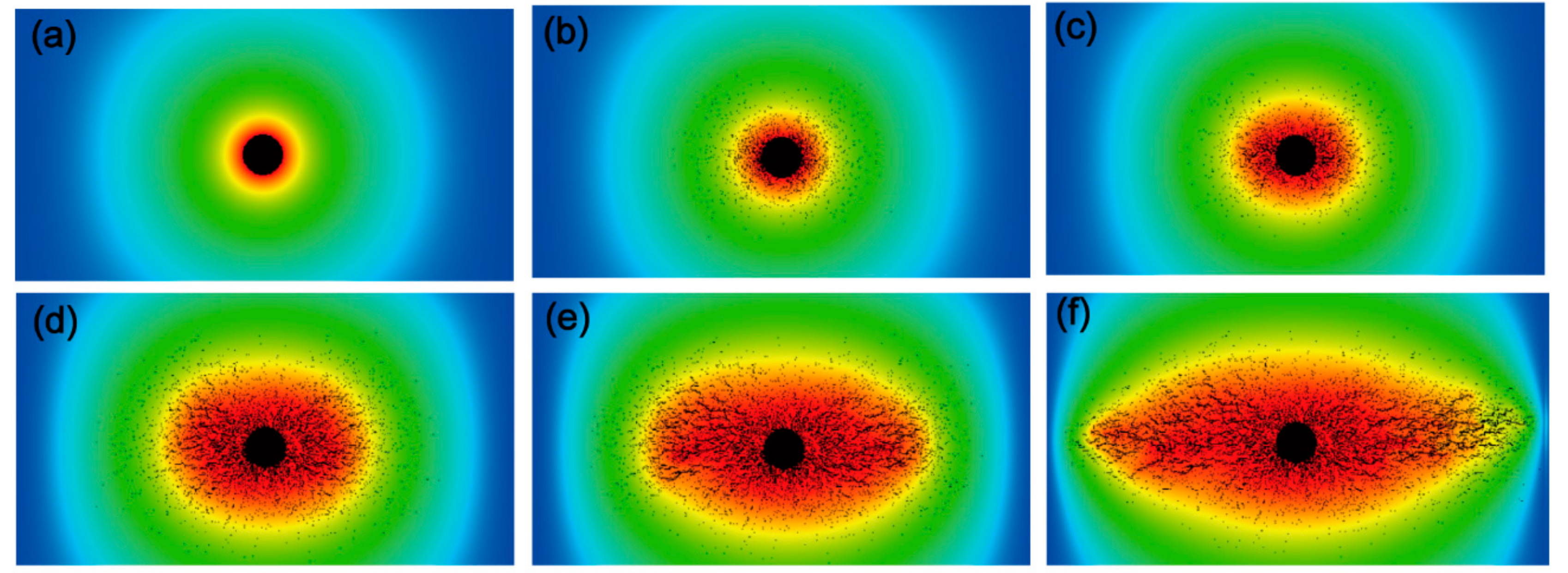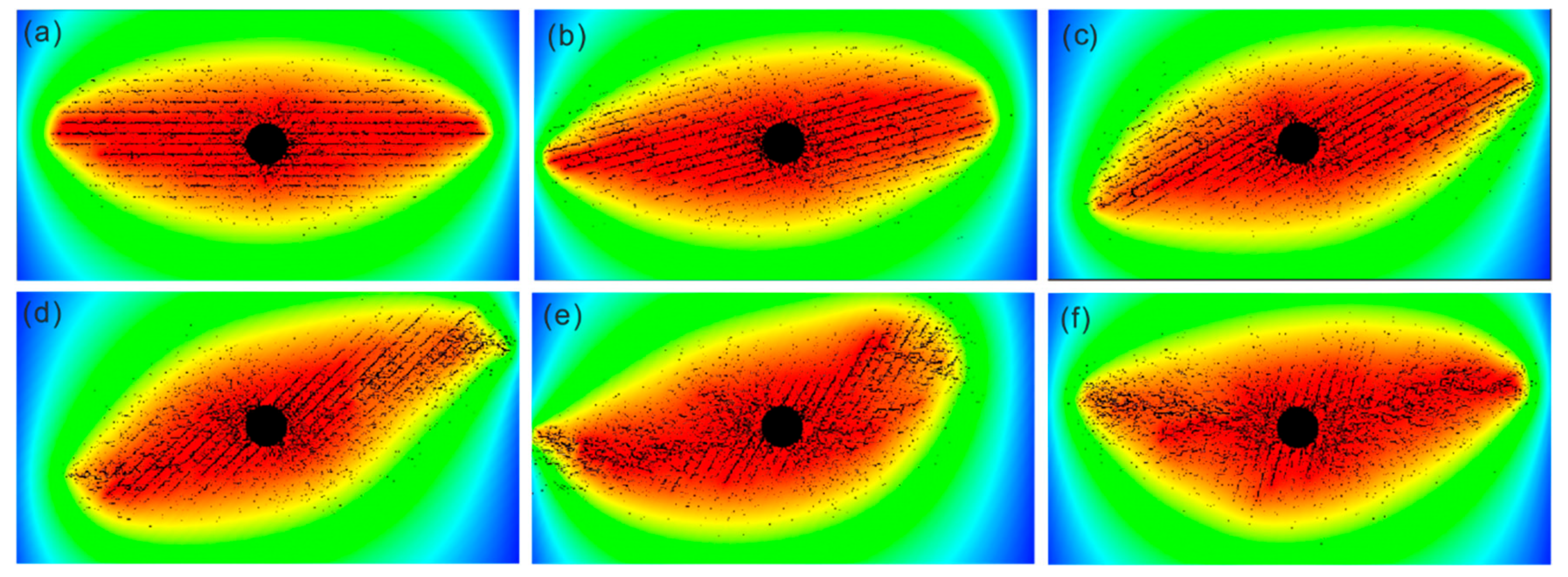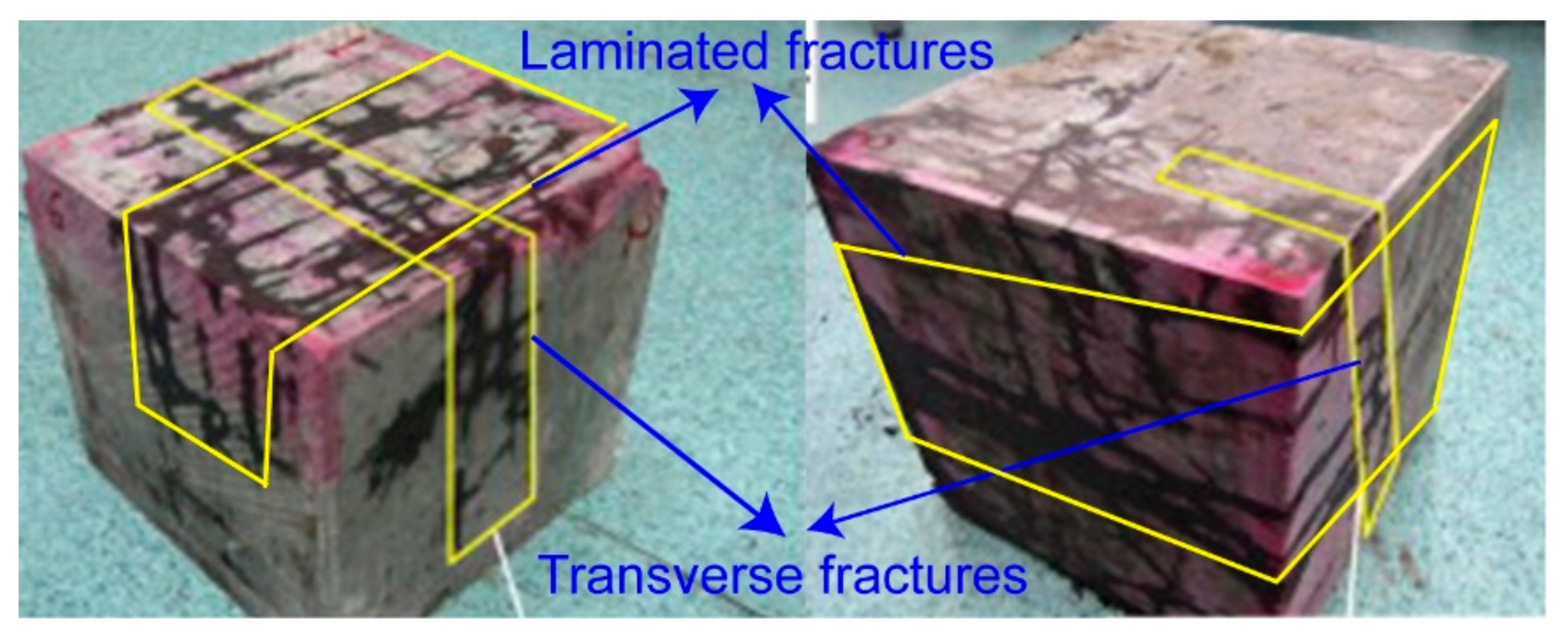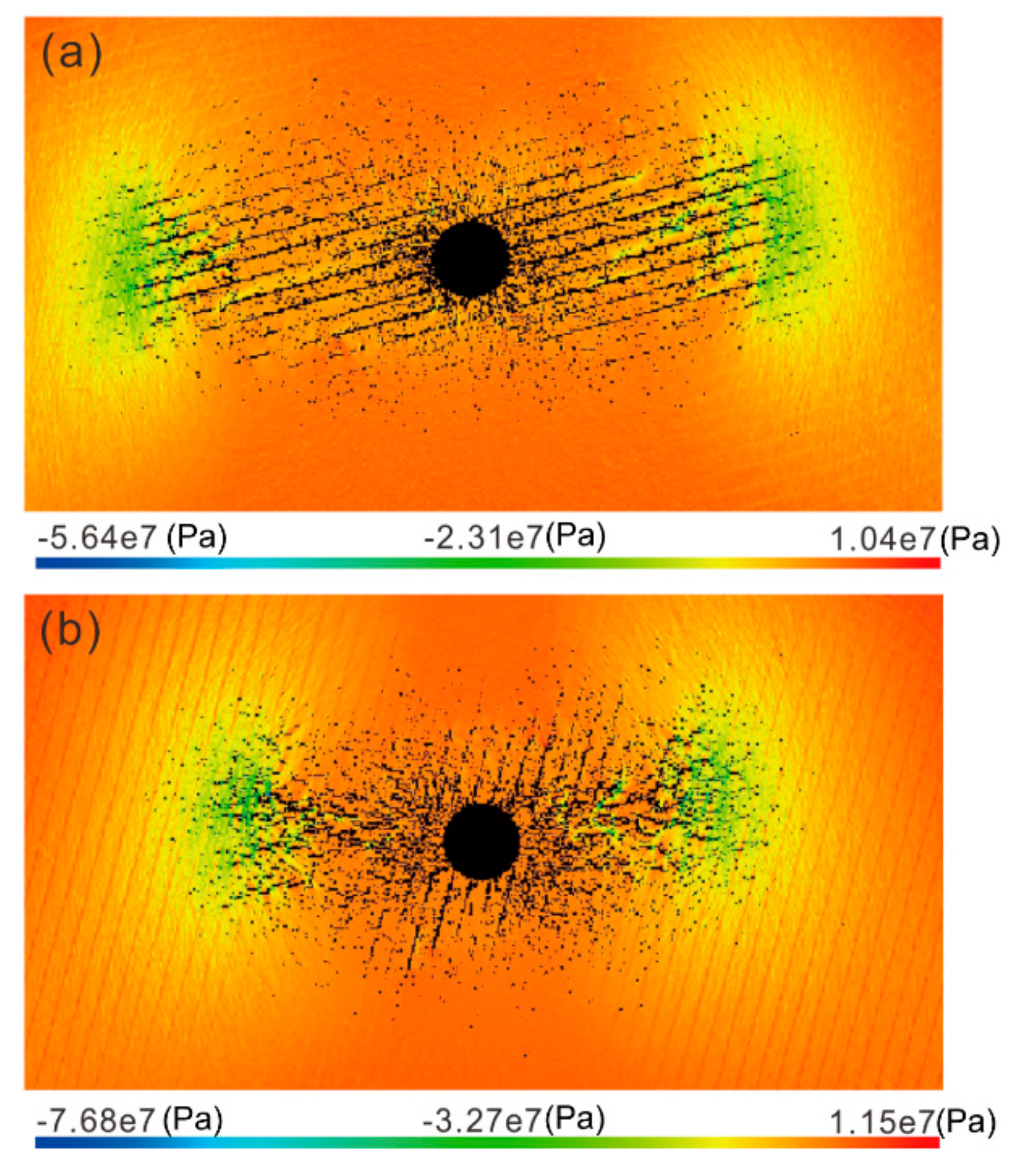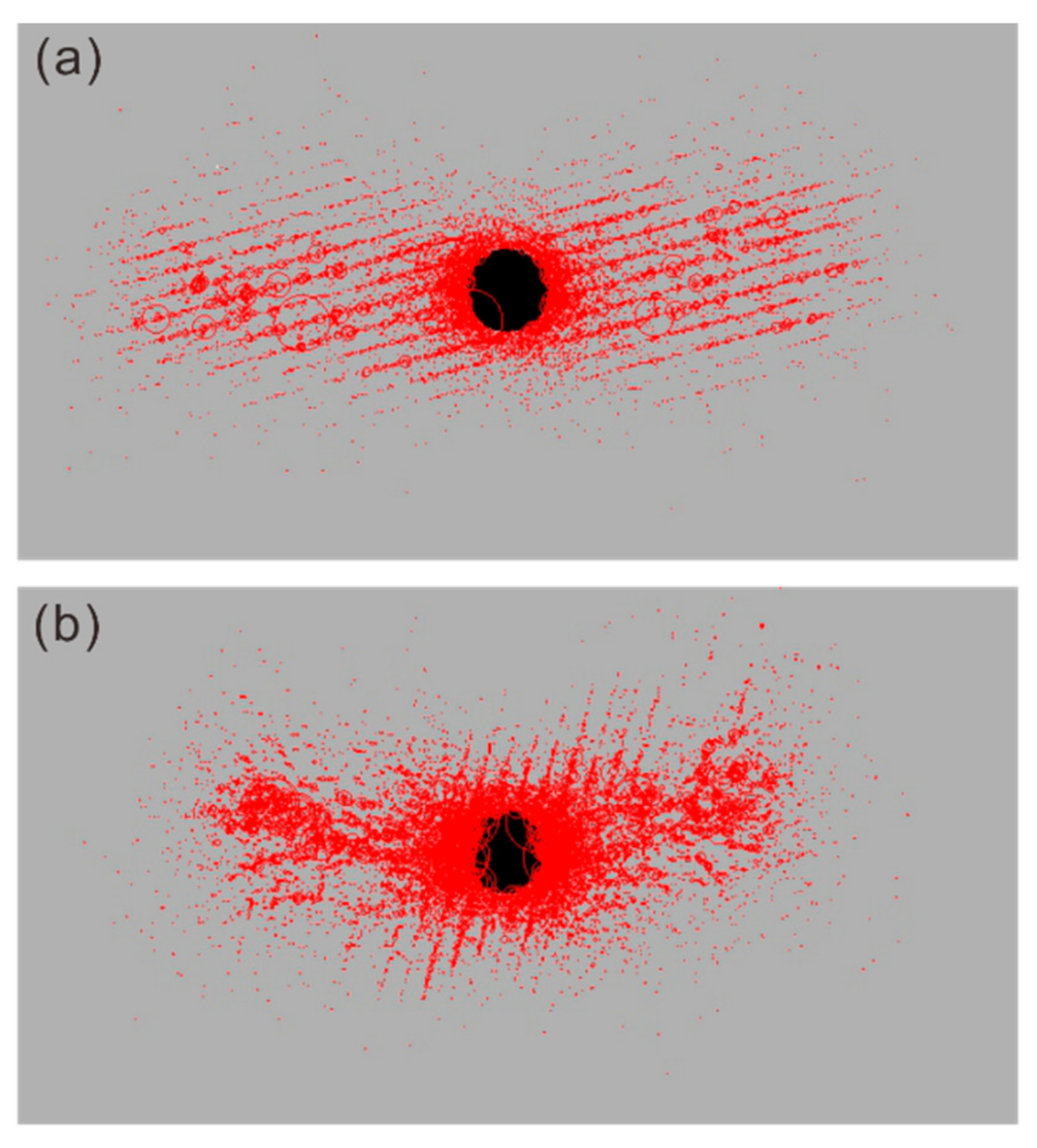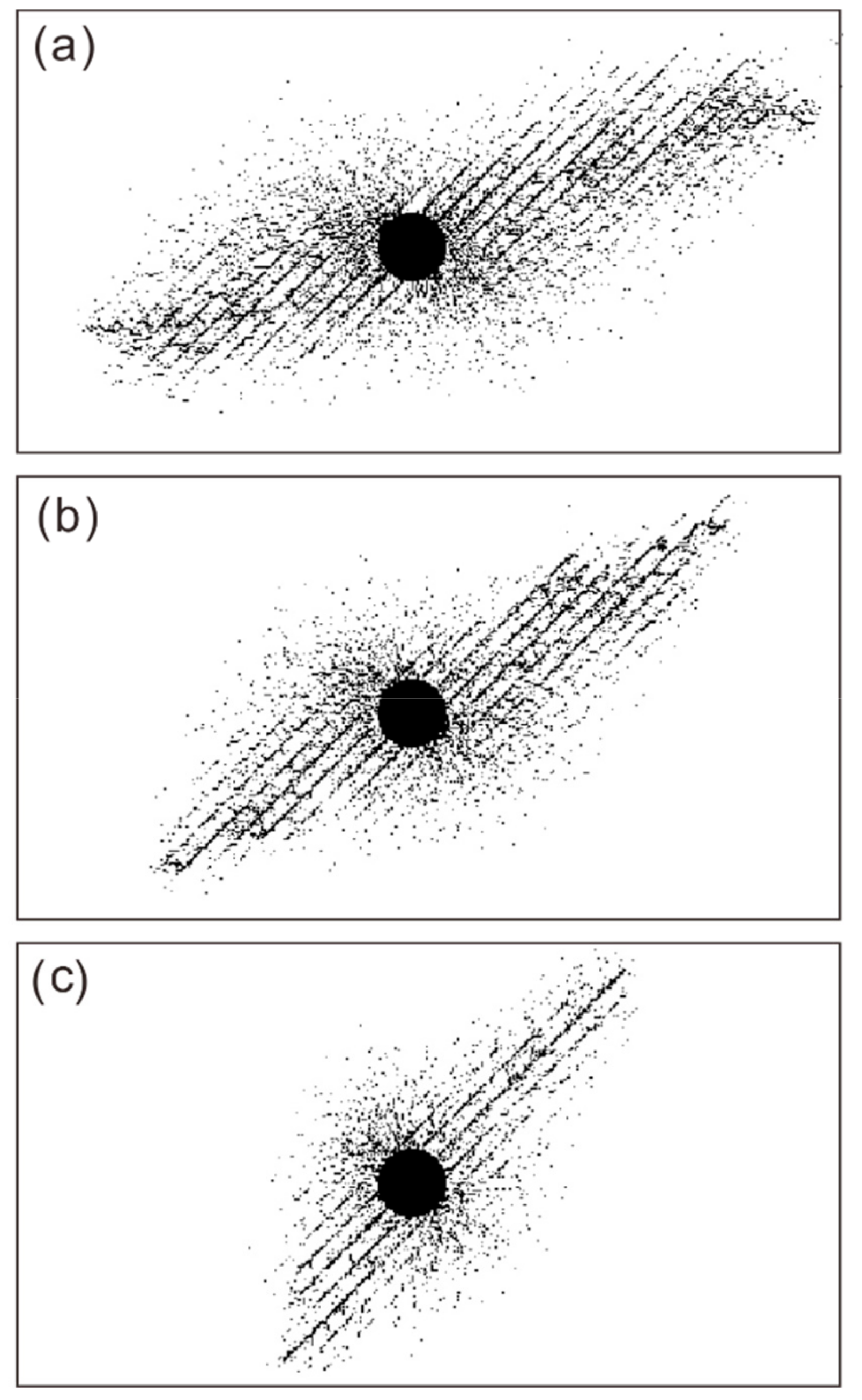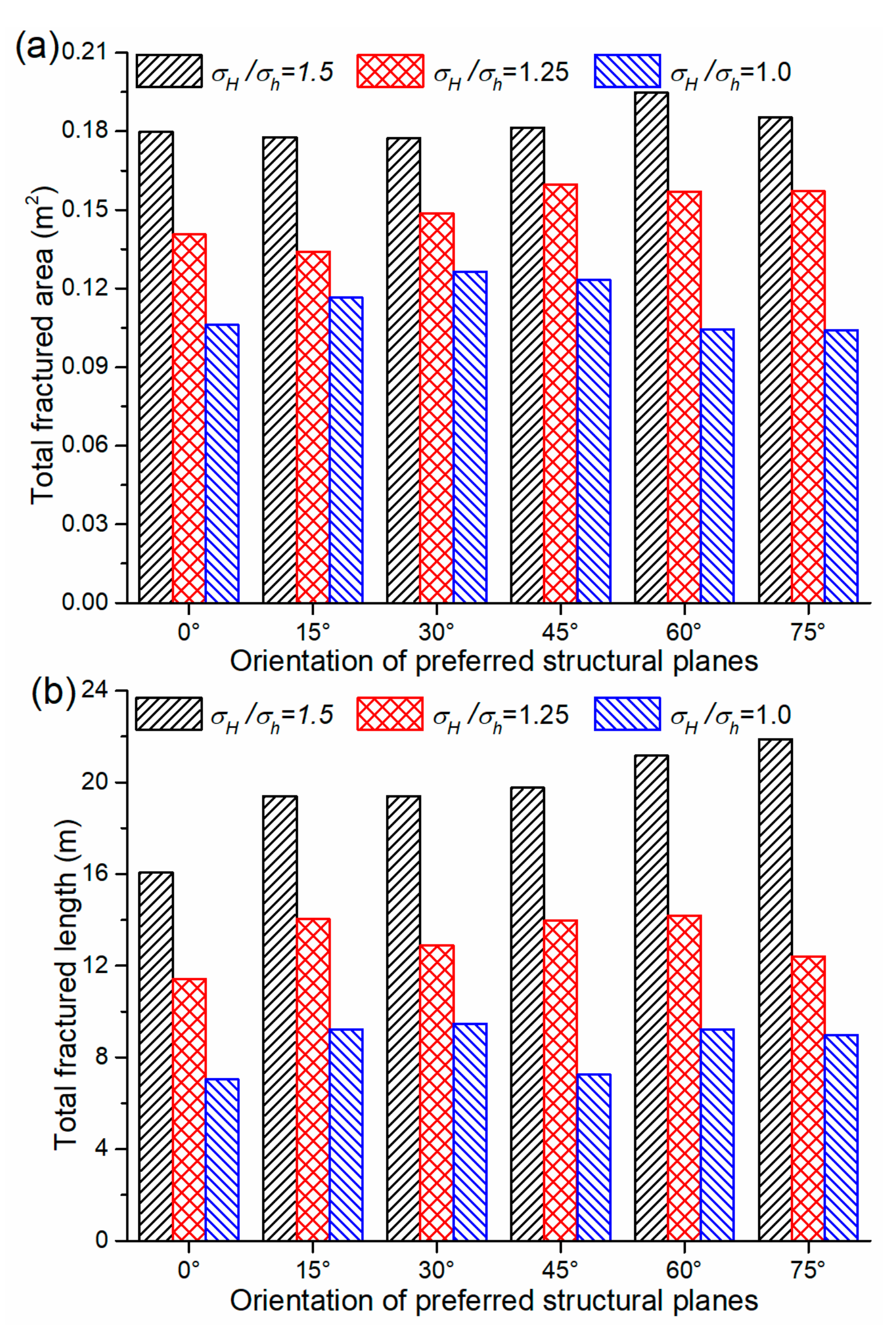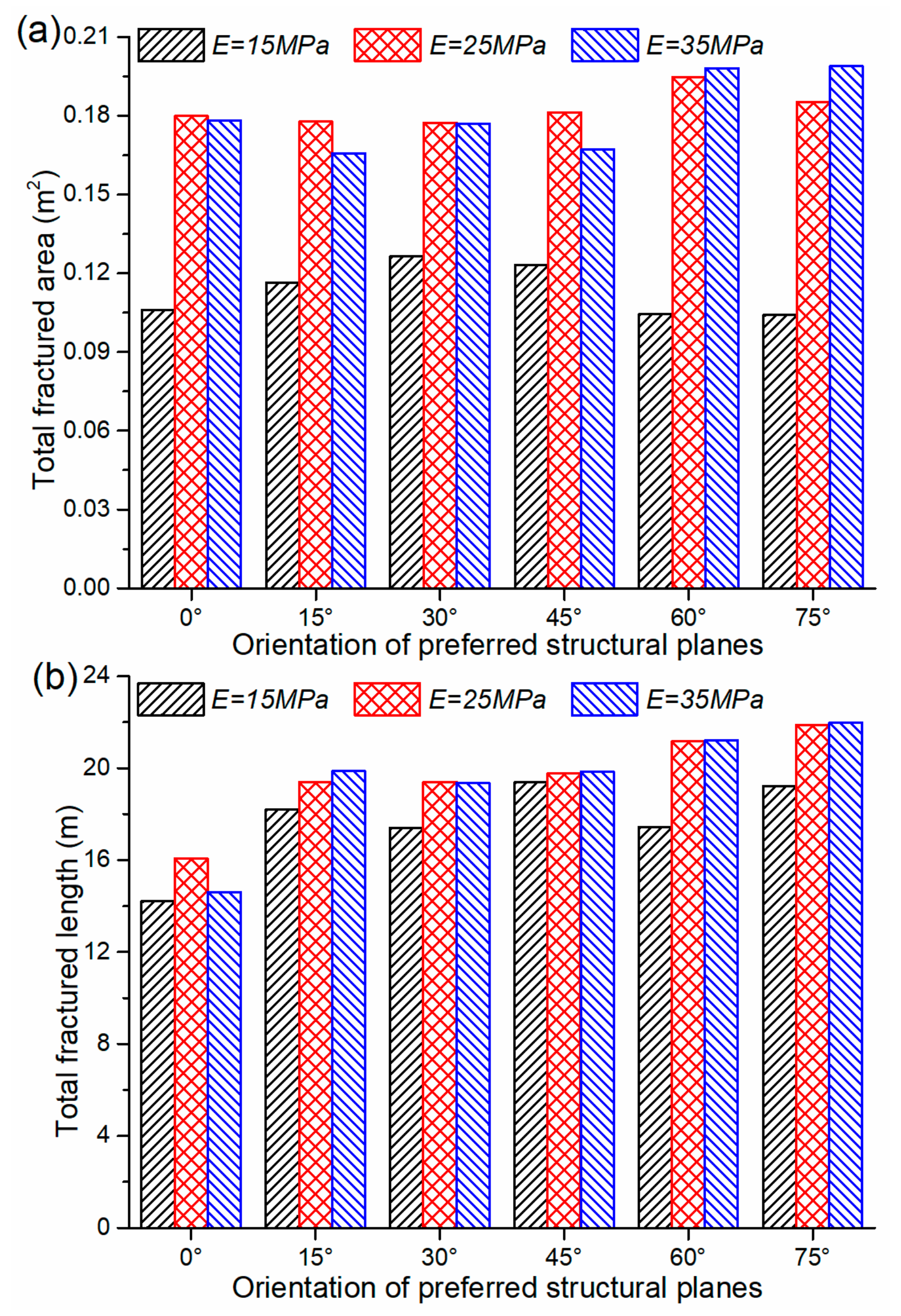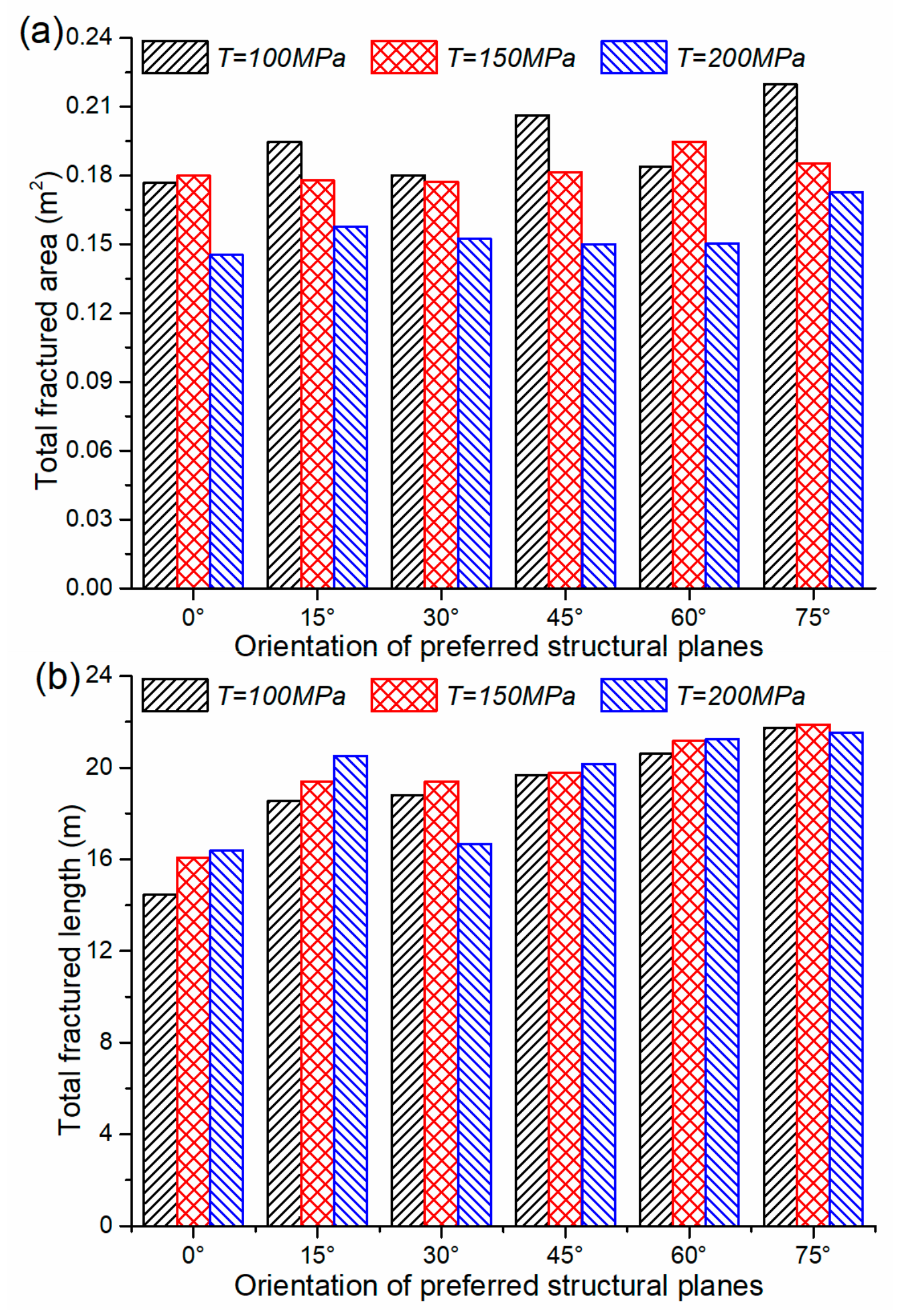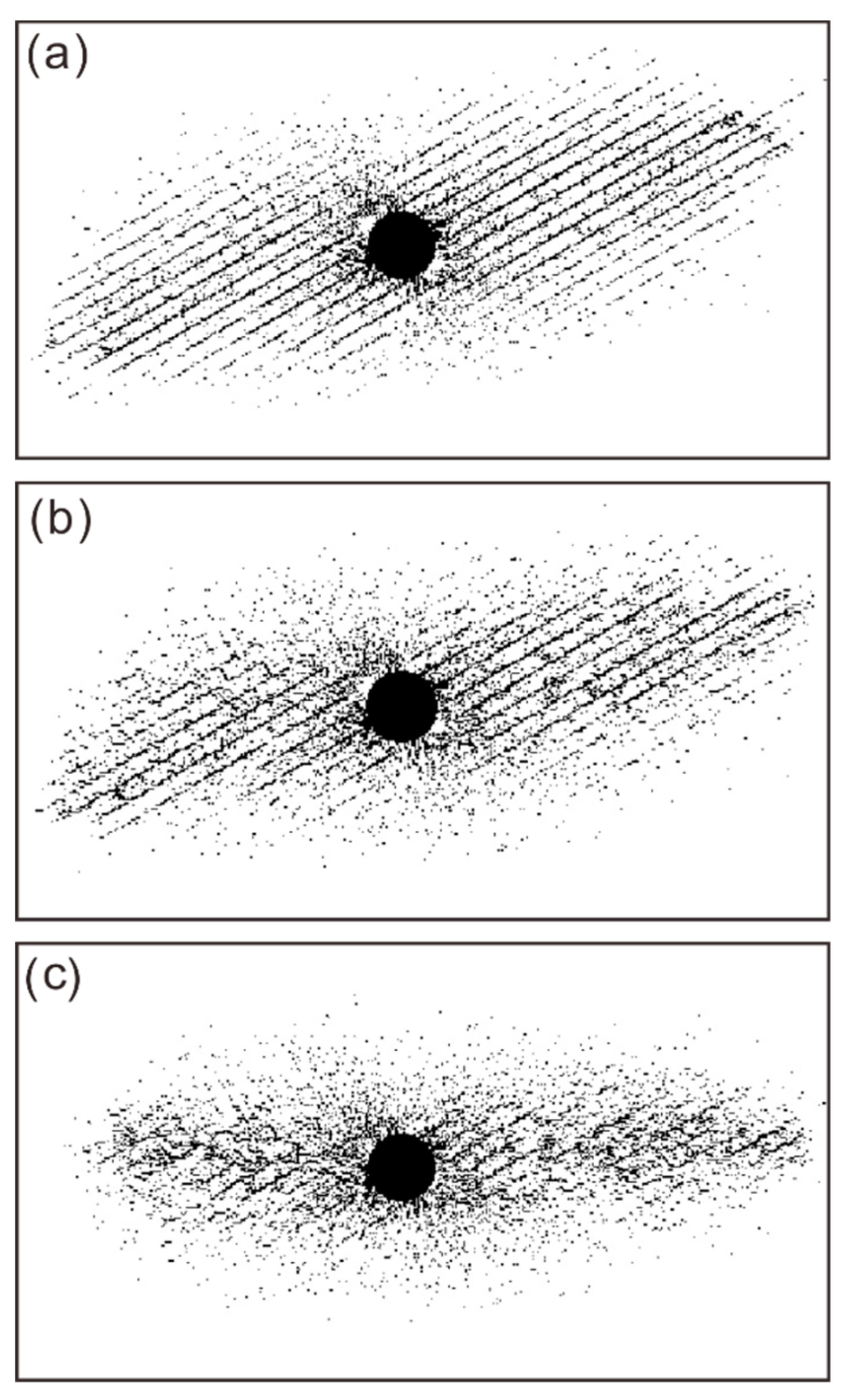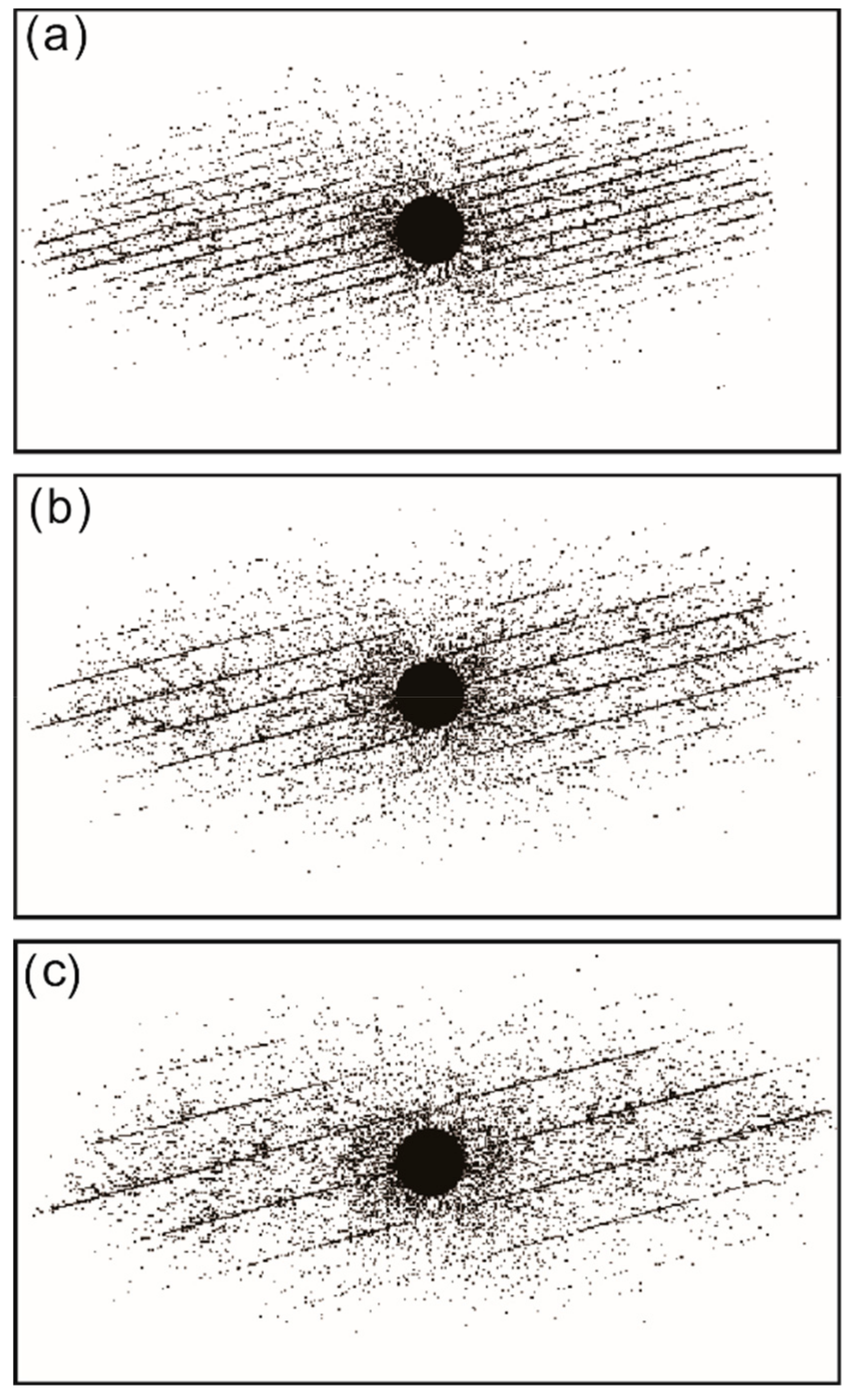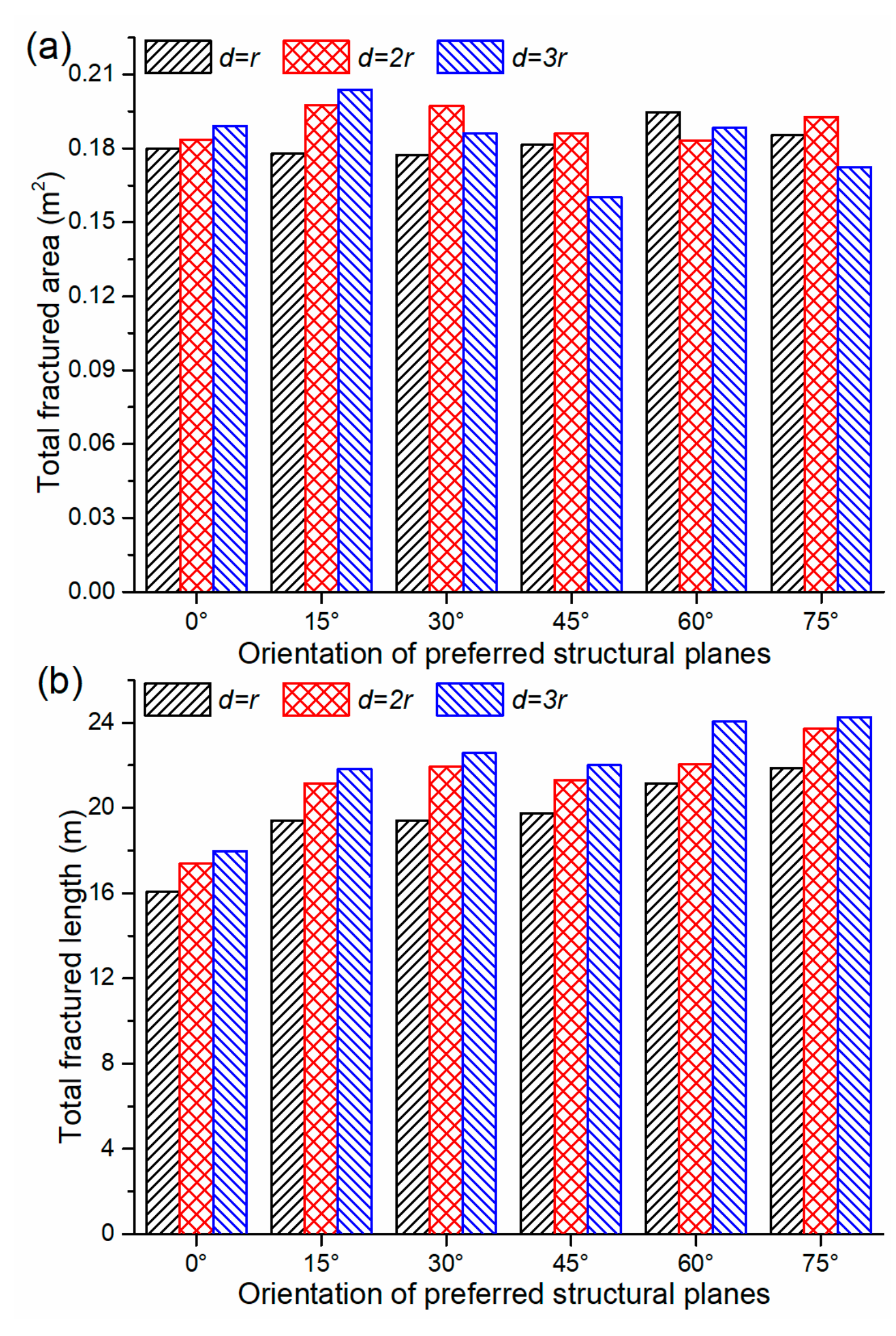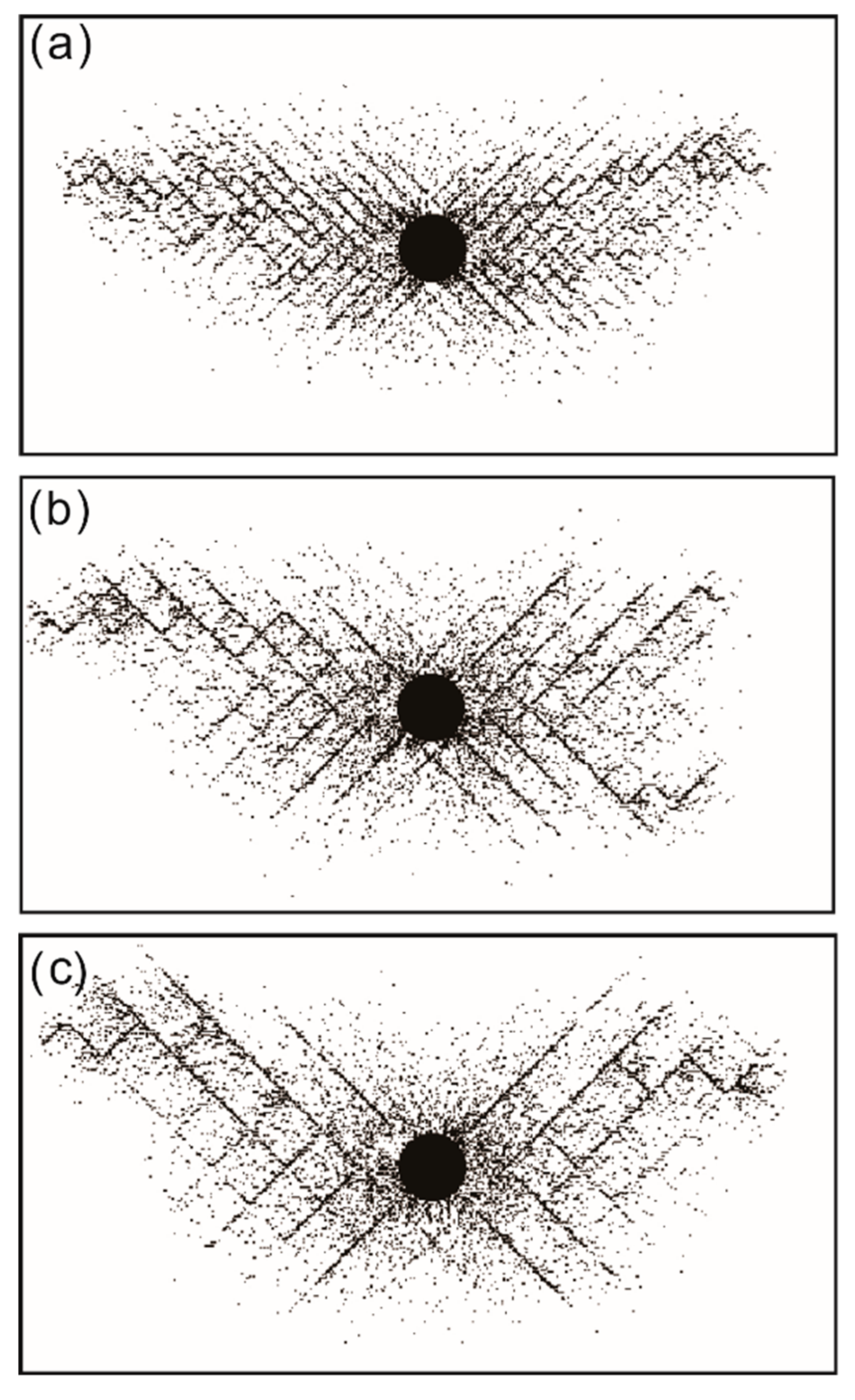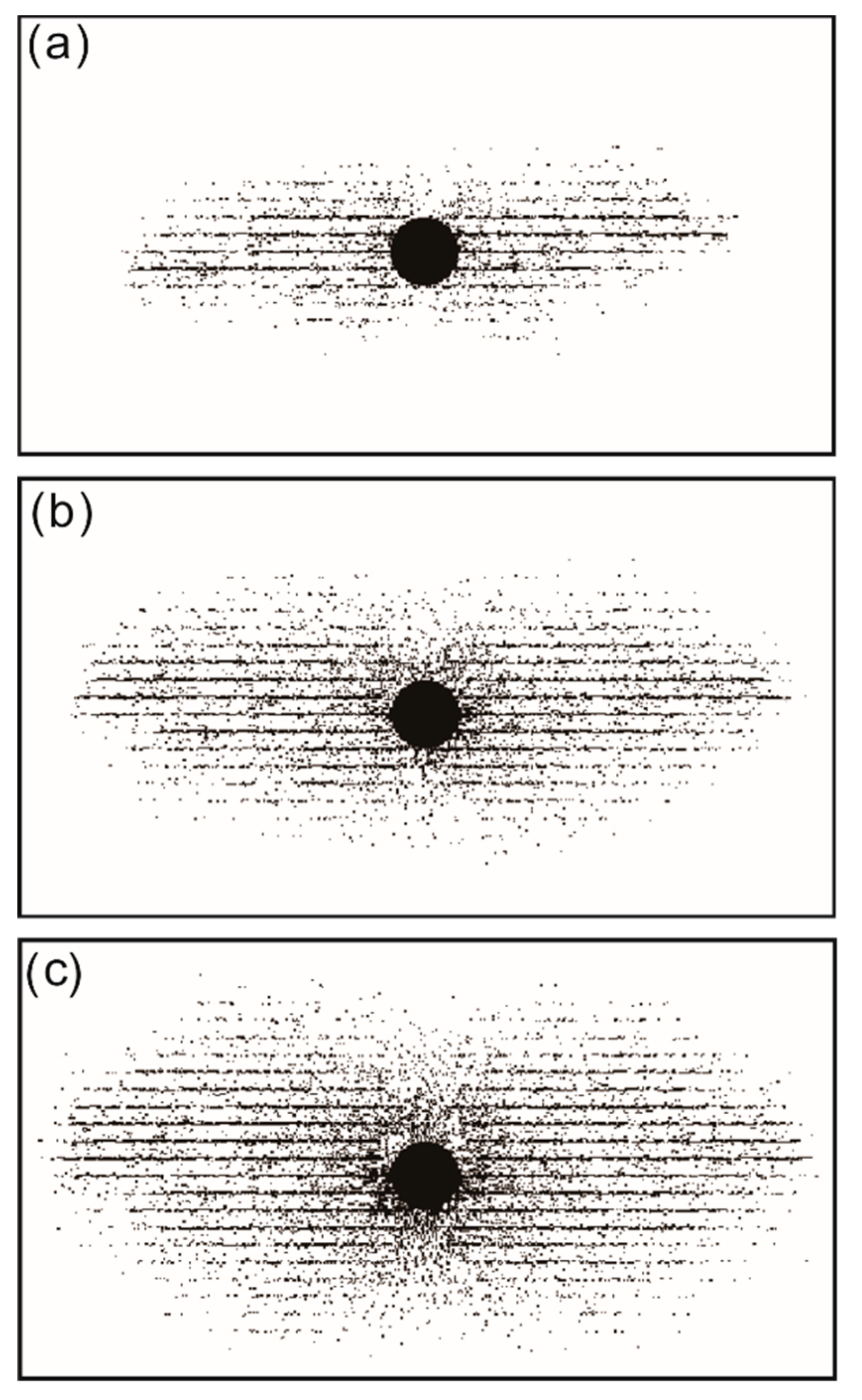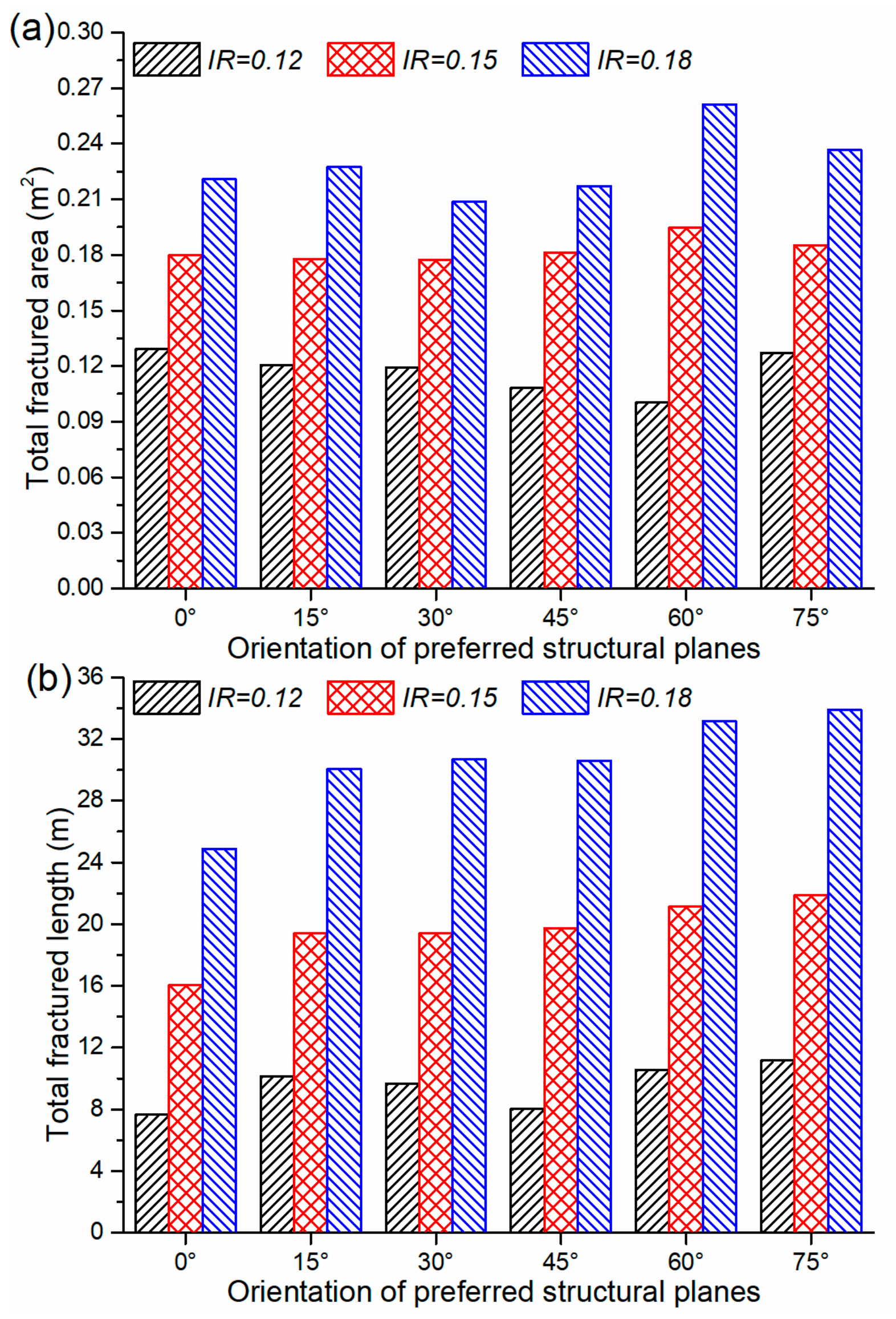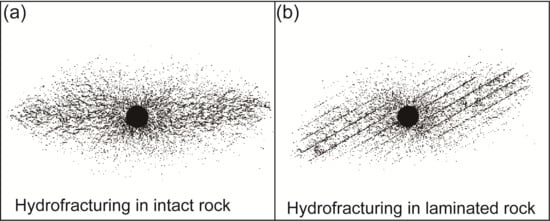1. Introduction
Hydraulic fracturing is an important technology for shale gas developement [
1]. This technology depends on multiple parameters, and fracture formation is dominated by several factors, e.g., the in-situ stress, the rock mass properties, and the injection rates [
1,
2]. The seepage pathway of fluid flow in a fractured rock mass is mainly controlled by the geometry, pattern, and heterogeneity of the hydraulic fracture network [
3,
4,
5,
6]. Therefore, the quality of the artificially modified fracture network is a critical factor in practical applications [
7,
8].
The anisotropic mechanical properties of rocks play an important role in the damage and stability of rock structures. Zhang et al. [
9] revealed that the deformation of Callovo-Oxfordian claystone depends on the orientation of the major principal stress to the bedding and the claystone strength depends on the loading path and direction with respect to the bedding. Valente et al. [
10] analyzed the mechanisms of parallel-to-bedding cracking through a sensitivity analysis and using a numerical Non-Linear Elastic Fracture Mechanics model. Kakouris et al. [
11] proposed a phase-field formulation within a material point method to simulate brittle fracture in anisotropic media. Bleyer et al. [
12] used a phase-field approach to model anisotropic fracture phenomena of elastic brittle materials. Shales are anisotropic due to their laminated structure [
13]. The geometry and pattern of a hydraulic fracture network are complex and often poorly understood in the field, despite the use of micro-seismic interpretation [
14,
15,
16].
Although the formation of fractures around injection wells has been extensively studied using computational, experimental, and field methods, the influence of pre-existing fractures on hydraulic fracturing still needs further study [
17]. During fracking, natural structural planes can influence the propagation of hydraulic fractures [
17,
18,
19]. In the last few years, reduced-scale experiments and simulations have been extensively carried out to elucidate the mechanisms and process of the interaction between induced and natural fractures. The existing natural fractures not only influence the propagation of hydraulic fractures, but can also be activated by the high-pressure injection fluid [
20]. Therefore, the interaction between the induced and natural fractures must be considered before hydraulic fracturing takes place. Various analyses have been reported in the literature to study the interaction between hydraulic and natural fractures in shale reservoirs [
8]. However, mechanisms for the formation of hydraulic fracture networks and how the failure modes are affected by weak structural planes is still poorly understood [
7,
13].
Among the various models, the linear elastic and isotropic constitutive model, together with the linear failure criterion, are the most frequently used methods [
21,
22,
23]. However, shale has anisotropic properties for deformation and strength because of its laminated rock mass structure [
5]. A few analytical solutions for fracture initiation and propagation in anisotropic formations have been developed to evaluate the fracturing [
8]. However, the coupling between the anisotropic damage and permeability variation in shale formations is a dynamic process, and the evolution of hydraulic fracturing is difficult to model and simulate.
Numerical modeling provides an approach to understand the hydraulic fracture initiation and propagation processes. Numerous modeling efforts have been conducted to understand the process and mechanism of hydraulic fracturing [
24,
25,
26,
27,
28]. Miehe et al. [
29] studied the hydraulic fracturing of a fluid-saturated porous media using a phase-field modeling method. Wilson et al. [
30] proposed a theoretical method implementing a phase-field approach to study the mechanisms of hydraulic fracturing. Ehlers et al. [
31] studied hydraulic fracturing processes based on the theory of porous media and a phase-field fracture model. Despite this arsenal of insights, techniques, and specialized knowledge, there is still a lack of understanding of the dynamic fracture propagation and the failure mechanisms in shale formations. Additionally, there are still a lack of satisfactory models that can explicitly represent the heterogeneity characteristics of shale formations and simulate the coupling between stress, fluid flow, and damage in ways that can be easily visualized [
4].
In shale fracturing simulation, the heterogeneity of reservoirs is one of the challenges that influence the fracturing and productivity prediction. Previous studies have indicated that a small change in the properties could result in a significant difference in the propagation direction and pattern of hydraulic fractures [
32,
33,
34]. In addition, another obstacle lies in understanding the irregular flow paths in heterogeneous formations [
35,
36,
37].
To study coupled flow-damage problems, a coupled flow-stress-damage (FSD) model was put forward by Tang et al. [
38,
39,
40,
41,
42] to simulate the fracture process under boundary stress and hydraulic conditions. This model was improved to incorporate heterogeneity in micro-mechanical properties [
33]. The most outstanding characteristic of the FSD model is that new fractures can be produced during the loading process. Discontinuous mechanical problems can be handled by integrating a strength reduction method into the model. In addition, the initiation and propagation of natural fractures are dynamic in the model. The interactions between the pre-existing and induced hydraulic fractures are automatically calculated. The FSD coupling approach was selected for the research presented in this paper because of its advantages and ability to simulate the interactions between induced hydraulic fractures and pre-existing fractures in heterogeneous rock.
In this study, the evolution of the hydraulic fracturing process is simulated in a model of anisotropic shale at the laboratory scale in which the shale microstructure was explicitly represented by inserting one or two sets of parallel discontinuities into the model. Through a series of modeling experiments, the influence of the discontinuities on the hydraulic fracturing was extensively investigated. In addition, hydrofracturing simulations were conducted to assess the influences of the in-situ stress ratio, the mechanical properties of the discontinuities, the discontinuity spacing, and the injection rate on the evolution of hydraulic fractures.
2. Modeling Methodology
The FSD coupled approach was derived from damage mechanics and statistical theory by considering the deformation of an elastic material containing a random initial distribution of micro-factures [
35,
38,
39,
40,
41,
42]. This modeling approach can simulate nonlinear rock behaviors and macroscopic rock fractures without knowledge of where and how the fractures will occur. Compared with other numerical methods, there are two distinct features: (1) By introducing the heterogeneity of rock parameters, nonlinear behavior in rock can be simulated, and (2) by introducing elastic modulus reduction after element failure, discontinuum mechanics can be simulated in a continuum mechanics model. For a more detailed description of the method, readers are referred to the references.
To simulate the progressive failure of the heterogeneous, permeable rock mass, the FSD coupled model assumes [
38,
39,
40,
41,
42] that (1) the flow of fluid in the model follows the Biot consolidation theory; (2) the model material is assumed to be elastic-brittle with residual strength and its failure can be described by elastic damage theory; (3) the Mohr–Coulomb criterion and the maximum tensile strength criterion can be used to define the tensile failure and shear failure of the rock; and (4) the permeability coefficient of the rock material is varied with the stress in an elastic state and increases dramatically according to a deformation-dependent law when the element progresses towards the failure stage. The continuum damage principle is applied and the fracture is presented as the damage zone. The basic equations used in the analysis are as follows:
Strain-displacement equation:
Seepage equation:
where
is the total stress in the ij-plane,
is the effective stress in the ij-plane,
is the density,
is the body force in the
j-th direction,
is the element displacement,
is the strain in the
ij-plane,
is the volumetric strain,
is the pore water pressure,
is the Lame coefficient,
is the Kronecker constant,
is the shear modulus,
is the coefficient of permeability,
is the pore-fluid pressure coefficient (dimensionless),
and
represent the Biot’s constant,
is a coupling parameter that reflects the influence of stress on the permeability coefficient,
is a damage factor of permeability (dimensionless),
represents the water capacity change due to changes in water pressure,
represents the change in the overall volume of the media due to changes in water pressure, and
represents the amount of water squeezed into the porous media under the action of water pressure without changing the volume of the porous media.
The relationship between the
,
,
, and
is
where
is the elastic modulus,
is the bulk modulus, and
is the Poisson’s ratio. In the process of steady flow, the flow tends to be stable as the pore water dissipates. Therefore, the value of Q is very large; assuming
, Equation (7) can be simplified as
A pore volume change of
causes a flow rate change. The permeability coefficient
is a function of the pore volume change
. Therefore, the coupling equation can be described as
Equation (9) is a negative exponential function that is applied to describe the relationship between stress and damage. The most important hypothesis reflected in the FSD model is that a heterogeneous distribution of rock strength causes rock failure behavior. The rock medium is assumed to be locally heterogeneous by randomly assigning the Young’s modulus and compressive strength to each element in a Weibull distribution [
39]:
where
is the mechanical parameter of the elements, such as elastic modulus or strength. The scale parameter
is related to the average value of the element parameter, and the parameter
defines the homogeneity index; a higher value of
represents a more homogeneous material. The strength distribution with different
m values is illustrated in
Figure 1.
In the FSD coupled model, the coupled effects of flow, stress, and damage on the fractures and the permeability of rock mass are considered [
44]. Both the tensile and shear failure modes are considered in the model calculation. The maximum tensile strain criterion and the Mohr–Coulomb criterion are used to define the types of deformation and breakdown. According to the elastic damage mechanics, the elastic modulus of the damaged material can be defined as [
39]
where
D represents the damage variable, and
E and
are the elastic modulus of the damaged and the undamaged elements, respectively.
When the tensile stress reaches its tensile strength,
where
is the tensile strength of the rock element. Then, the damage variable can be described as [
39]
where
is the residual tensile strength of the element,
is the equivalent principal strain,
is the threshold strain, and
is the maximum tensile strain of the element. Then, the permeability can be described as
where
is a damage factor of permeability,
is the initial coefficient,
is the pore-fluid pressure coefficient (dimensionless),
is a coupling parameter, and
is the pore water pressure.
In the FSD coupled model, tensile failure of the element occurs if the element’s strength is smaller than the minor principal stress, and shear failure occurs when the compressive or shear stress satisfies the Mohr–Coulomb failure criterion:
where
and
are the maximum and minimum principal effective stresses,
is the effective angle of friction, and
is the compressive failure strength. In this case, the damage factor under uniaxial compression can be described as
where
is the residual compressive strength and
is the maximum compressive strain. In this case, the permeability can be defined by
3. Model Setup for Hydraulic Fracturing Simulation
For this study, bedding joints and crossing joints were the structure planes considered in the modeling simulation.
Figure 2 shows the basic geometry and model setup, which represents a 2D horizontal section of a reservoir. The model is composed of 250,000 (500 × 500) identical 2 mm square elements. The element size is small enough for the accuracy requirement of the model, and no further re-meshing was needed. A vertical wellbore with a radius of 20 mm is in the center of the model and serves as the injection hole during the simulation.
In models with structural planes, the bedding angles are 0°, 15°, 30°, 45°, 60°, and 75°. The spacings of structural planes are 1.0, 2.0, and 3.0 times the radius of the injection hole. As shown in
Figure 2, a constant stress boundary condition was used to simulate an analogous in-situ stress environment. For the base model, the stresses in the x (σ
H) and y (σ
h) directions on the model boundary were 12 MPa and 8 MPa, respectively. In the cross joint models, two sets of structural planes with inclination angles of 45° and 135° were used. The stresses on the model boundary were set to 12 MPa and 8 MPa or 10 MPa and 10 MPa, respectively. The hydraulic fracturing process was simulated under the condition of a constant injection rate of 0.15 m
3·s
−1·m
−1.
The material mechanical parameters used in the FSD coupled model were calibrated through a series of trial-and-error experiments [
44]. The microparameters were calibrated to match the macro properties of the Longmaxi shale rock, including the elastic modulus, peak strength, and Poisson’s ratio. The mesoscopic physical and mechanical parameters of the model used in this study are shown in
Table 1.
5. Fracturing Response to Geological and Operational Variables
In addition to a qualitative evaluation of the simulation results, the fracturing response and the efficiency of hydraulic fracturing under different geological conditions were quantitatively investigated. Key parameters, such as the stress ratio, the structural plane spacing, the strength of the structural plane, the number of sets of structural planes, and the injection rate were studied to reveal their effects on hydraulic fracturing. Here, two parameters were defined to quantitatively analyze the effects of the different factors on hydraulic fracturing. These indices are (1) the hydraulically fractured area, defined as the area of the pre-existing structural planes that experience failure, and (2) the length of hydraulic fractures, defined as the total length of the created fractures.
The hydraulically fractured area corresponds to an area with a significant pore pressure increase due to injection. The length of hydraulic fractures is the total length of the failed structural planes and newly created fractures. These parameters were quantified through computer image recognition and statistical techniques to ensure their reliability and validity.
5.1. Effect of In-Situ Stress Ratio
The in-situ stresses in a reservoir significantly affect the performance of hydraulic fracturing [
26,
50]. The stress ratio, which is defined as the ratio of
σH/σh, was studied to evaluate its effect on the response to fluid injection during hydraulic fracturing.
Figure 8 shows the simulated fracture networks with stress ratios equal to 1.5, 1.25, and 1.0. The fracture network zone decreases in size as the stress ratio approaches unity. In addition, the simulation results indicate that the orientation of the long axis of the fractured zone also changes with different stress ratios. Specifically, when the stress ratio equals 1.0, the direction of the fracture zone is about 70° to
σH; when the stress ratio equals 1.25, the direction of the fracture zone is about 45° to the maximum horizontal stress; and when the stress ratio equals 1.5, the direction of the fracture zone is about 20° to
σH. In addition, the simulation results show that a large stress ratio is conducive to the development of relatively more branching fractures in the direction of
σH, which can enhance the connectivity of the hydraulic fractures and add to the complexity of the fracture network morphology.
Figure 9 shows the impact of the stress ratio on the hydraulically fractured area and the length of fractures. The results indicate that the fracture pattern is significantly affected by the stress ratio. For the same injection rate and duration, a higher stress ratio achieves a larger number of simulated fractures and a larger fractured area.
5.2. Effect of Structural Plane Mechanical Properties
It is generally known that the properties of joints or bedding planes have a significant impact on the deformation and failure behavior of a rock mass. In shale fracturing, the mechanical properties of the structural planes represent an important issue, which cannot be ignored in the design of hydraulic fracturing. The structural planes in the numerical models are elements with lower mechanical properties than the rock matrix. Different elastic moduli of structural planes were assigned to the models to evaluate the effect of the stiffness and strength of the structural planes on the hydraulic fracturing.
Figure 10 shows the quantitative results of the simulated fracture network when the structural planes have different elasticity moduli. The fractured area and length of fractures changed slightly with an increase of the elastic modulus of structural planes, which were 30%, 50%, and 70% of the rock matrix, respectively. There was no significant change in the morphology of the fractured zone with an increase of elasticity moduli.
Figure 11 shows the fractured area and length of fractures when the structural planes have different uniaxial compressive strengths. The default tensile-compression strength ratio of material in the FSD is 10. Therefore, changes in the uniaxial compressive strength of the structural planes are essentially paired with changes in the tensile strength in this study. The results suggest that the fractured area increases with a reduction in the uniaxial compressive strength of the structural planes, but the length of fractures in the fracture network decreases.
Figure 12 shows the qualitative results of the simulated fracture network when the structural planes have different compressive strengths. The strength of the structural planes has an important influence on hydraulic fracturing. At a strength of 100 MPa, the hydraulic fractures initiated and propagated rapidly along the weak structural planes, and only a few small branching fractures were induced between the main hydraulic fractures, resulting in poor connectivity of the fracture network. At a strength of 150 MPa, although the zone of failed structural planes is smaller than the former case, there are more branching fractures between the structural planes. In this case, the structural planes still dominated the evolution of hydraulic fractures. At a strength of 200 MPa, which is very close to the strength of the rock matrix, the morphology of the fracture network is distinctly different. Here, the impact of the structural planes on hydraulic fracturing is not apparent, and the morphology of the fractured zone is similar to the base model.
5.3. Effect of Structural Plane Spacing
As stated before, natural structural planes typically form a key part of a hydraulic fracture network. Therefore, the structural plane spacing and the number of sets of planes can inevitably affect the morphology of the fracture network and the effectiveness of the hydraulic fracturing. A group of structural planes with different spacings was studied. For example, with an orientation of the structural planes equal to 15°,
Figure 13 shows the distribution of the simulated fracture network when the structural planes have different spacing. The structural plane spacing influences the morphology and connectivity of the fracture network. The failed structural planes dominate the development of the hydraulic fractures and control the pattern of the fracture network. Simulation results with a smaller spacing generate more complex fracture networks and better fracture connectivity.
Figure 14 shows the fractured area and the total length of fractures for structural plane spacings of 1, 2, and 3 times the radius of the injection hole. The fractured area did not vary significantly for different spacings, but a reduction in spacing resulted in a decrease in the total length of fractures that were created.
There may be multiple sets of structural planes in a reservoir. To study this more complex geological condition, the effect of the structural plane spacing on the hydraulic fracturing for two sets of weakness planes was also simulated.
Figure 15 shows the qualitative characteristics of the simulated fracture networks for two sets of orthogonal structural planes with different spacings. In this case, the structural planes still dominated the morphology and connectivity of the fracture network. Although the model with wider spacing for the structural planes achieved a larger fractured area, it had fewer hydraulic fractures and poor connectivity compared to the model with closer spacing.
5.4. Effect of Injection Rates
The injection rate is one of the most important operational parameters when conducting hydraulic fracturing in shales [
3,
5]. Although it was believed that large injection rates can enhance the propagation length of fractures [
8], the quantitative relationship between the injection rate and the reservoir fracturing is still largely unknown [
4]. In this study, different injection rates were tested to study their effects on hydraulic fracturing.
Figure 16 shows the qualitative results of the simulated fracture network with injection rates equal to 0.12, 0.15, and 0.18 m
3·s
−1·m
−1, with the structural planes parallel to
σH. The injection rate affects the growth and development of the fracture network during the hydraulic fracturing. High injection rates create a larger fractured area and a longer total fracture length. The fractured area and number of fractures increased with the injection rate. For a high injection rate, the injection fluids not only fracture the structural planes, but also initiate small fractures in the rock matrix. In contrast, for a lower injection rate, the time required to reach the breakdown pressure of the shale may be longer, thus resulting in less fractured structural planes and high rates of fluid leak-off into the formation.
Figure 17 shows the quantitative results of the fractured area and length for different constant injection rates. The results show that higher injection rates result in better hydraulic fracturing. At a low injection rate, the fracturing fluid tends to only flow along the structural planes in the direction of
σH. However, at a high injection rate, multiple random branches of hydraulic fractures form, creating a more complex and connected fracture network.
6. Conclusions
The evolution of hydraulic fracturing in bedding or laminated rocks was investigated through a micromechanics-based 2D numerical modeling approach. The numerical models incorporated heterogeneity in the mechanical properties of the rock and all models other than the base model included planes of weaker elements to simulate the presence of structural features, such as bedding planes in the rock. The mechanical-hydraulic coupled process between the rock and the injected fluid was also incorporated in the models. A series of simulations were conducted to explore the effect of the rock’s mechanical properties and fluid injection rates on the initiation and propagation of fractures and the resulting morphology of the fracture network created.
The process of hydraulic fracturing in laminated rock can be divided into five stages: stress accumulation, small fracture formation, hydraulic fracture initiation, hydraulic fracture propagation, and decay in fracture propagation. Heterogeneity in rock properties influences the fracture initiation and propagation, and the location and orientation of fracture initiation are unpredictable.
The angle between the orientation of the structural planes and the maximum horizontal stress has a significant effect on the propagation and evolution of the fracture network. When the structural planes are nearly parallel with the direction of σH, the weak structural planes dominate the propagation direction and the morphology of the fracture network. When the orientation of the structural planes is significantly different from the direction of σH, the extent and morphology of the fracture network are controlled by both the in-situ stresses and the orientation of the structural planes. In this case, many small transverse secondary fractures can occur in conjunction with fracturing along the structural planes. The acoustic emission events induced by the hydraulic fracturing demonstrated that most of the failed elements are caused by tensile failure at the microscale.
The in-situ stress ratio has a great impact on the morphology and extent of the fracture network. For a fixed injection rate and duration, a high-stress ratio creates a larger area of fractured rock with a better connectivity. The stiffness of the structural planes has minimal influence on the extent and morphology of the fracture network, but the mechanical strength of pre-existing weakness planes, the plane spacing, and the injection rate have a significant effect on the hydraulic fracturing. Small structural plane spacing, a high strength contrast, a high-stress ratio, and a high injection rate result in a complex interconnected network of hydraulic fractures.
